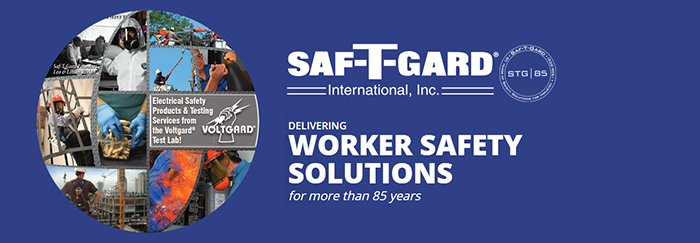| |
Get Back to Work Safely with These
COVID-19 Safety Essentials from Saf-T-Gard
|
| |
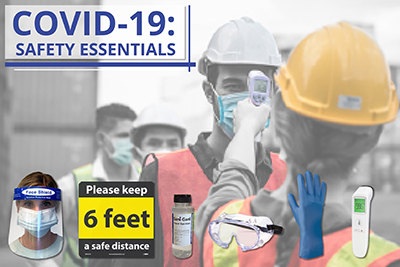
|
| |
The first "P" in "PPE" stands for
"Personal", and never before has safety been more personal than it is
now with COVID-19 affecting the lives and livelihoods of
everyone.
No one understands this better than Saf-T-Gard International, Inc. After
all, safety is rooted in our name. So when it comes to your workers' safety, you can trust that
Saf-T-Gard has everything you need to work worry free, including the following:
|
| |
We've been bringing workers home safely for more than 85 years, and we can do the same for you!
Click here to shop our selection of COVID-19 Safety Essentials to Keep Your Business Running online, or call customer service at 1-800-548-GARD (4273) today for more information or to place an order or with any additional questions on how we can assist you in your worker safety program.
|
| |
|
| |
Enter to Win a FREE SureWerx Pioneer® 5408AU Heated Safety Bomber Jacket from Saf-T-Gard |
| |


|
| |
The revolutionary SureWerx Pioneer® 5408AU Heated Safety
Bomber Jacket is made from new 3rd generation Carbon Nanotube
Technology (CNT) heating elements that are extremely thin (5 microns), machine
washable, soft to the touch and flexible with no wires. The heat sensor is
strategically located to accurately measure temperature and prevent over or
under heating.
There are four (4) heat settings (100°F/108°F/118°F/127°F)
indicated by colored LEDs. Simply select your preferred heat setting by
pressing the control button. This jacket is compatible with various power banks
and includes a USB port (power bank not included).
Additional features and benefits include the following:
- Made using 300 Denier Oxford material with polyurethane
coating that is 100% waterproof and 120GSM insulated material with taffeta
lining
- Double-stitched with heat-sealed seams to prevent moisture from
entering the garment
- Exclusive StarTech™ style reflective tape far exceeds ANSI/ISEA
107-15 for high visibility
- Jacket comes in Hi-Viz yellow color with a black bottom to
conceal soiling and offer superior visibility and safety on the job
- Meets ANSI/ISEA Class 3 Type P and R requirements for those
working in dangerous settings where visibility is the highest priority,
including EMS, construction and traffic control
- Heavy-duty coat can be worn as rain or snow work gear and
includes a full-front waterproof zipper, two (2) lower slash pockets with
waterproof zipper, one (1) lower inside zip pocket and lower chest zip pocket,
two (2) radiophone clip straps, three-piece lined detachable hood and elastic
ribbed wrist cuffs and waist
- Available in sizes Small-4XL
Click here to enter to win a FREE SureWerx Pioneer® 5408AU Heated Safety Bomber Jacket, or click here
to shop the SureWerx Pioneer® 5408AU Heated Safety
Bomber Jacket online, or call customer service at 1-800-548-GARD (4273) today for
more information or to place an order.
|
| |
|
| |
Vendor Product Spotlight: Accuform® TAR114 Tags-By-The-Roll: DANGER DO NOT OPERATE (LOTO) |
| |
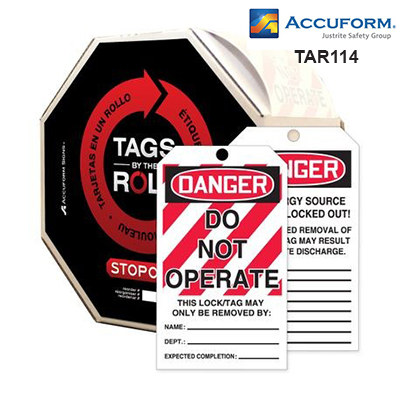
|
| |
Stop wasting time searching for the tags you need right away
with Accuform® TAR114
Tags By-The-Roll. Prevent your workers from misplacing their
tags before they get to work by carrying Tags-By-The-Roll to jobsites or
worksites. Tags-By-The-Roll provide a convenient solution for keeping a large
quantity of tags readily available and organized in one octagon-shaped
disposable dispenser.
When you need a tag, simply separate at the perforations and
place your Accuform® TAR114
Tags By-The-Roll: DANGER DO NOT OPERATE (LOTO) Tags on hazardous
energy sources or wherever needed to keep others safe. Tags-By-The-Roll are
durable, tear-and water-resistant, and are available with stock and custom
legends.
Additional features and benefits include the following:
- Identify temporary hazard until that hazard is eliminated or
hazardous operation is complete
- Comply in accordance with OSHA 29 CFR 1910.145 and ANSI Z535
requirements
- Thin, flexible 10-mil poly-based cardstock tags that are
connected end-to-end with perforations and housed in an innovative, convenient,
portable cardboard dispenser providing a large quantity of tags to be readily
available
- 6 5/8” x 6 5/8” x 3 5/8” octagon-shaped dispenser has 1 ½”
perforated center hole that can be removed for mounting
- PF-Cardstock tags have no wood content, are longer-lasting,
durable, tear-resistant, waterproof, and will not crack, distort, or shrink
when compared to traditional paper cardstock
- Easy to write on matte surface has 3/8” plain top,
pull-resistant hole
- 100/roll; sold by the roll
Click here
to shop the Accuform® TAR114
Tags By-The-Roll: DANGER DO NOT OPERATE (LOTO) Tags online, or call customer service at 1-800-548-GARD (4273) today for
more information or to place an order.
|
| |
|
| |
Are You Wearing the Right Apparel for the Controlled Environment?
|
| |
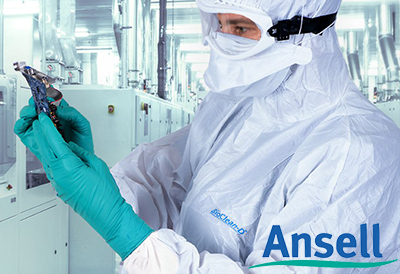
|
| |
Selecting the right consumables for use in your ISO Class
cleanroom is vital in order to protect the sensitive Life Sciences processes
being performed, whilst ensuring the finished products stay protected from
sources of potential contamination.
There is currently no international standard for consumables
worn within the cleanroom, instead the cleanrooms themselves have a cleanliness
classification which is known as the ISO Class. The standard defines the
maximum allowable concentration of particles per square meter for eight Class
of cleanroom ranging from 1 – 8, with 1-3 being the cleanest, and which do not
normally have any or very limited human intervention.
The biggest source of contamination to a cleanroom are humans,
whom shed up to 100,000 particles per minute when sitting/standing, so it’s
imperative that the appropriate clothing is worn to contain contamination and
stop it from entering the controlled environment. In state-of-the-art ISO Class
4 cleanrooms no more than 352 particles of size 0.5µm per cubic meter may be
present, and in an ISO Class 5 no more than 3520 particles.
The IEST-RP-CC003.3 standard for Garment system
consideration for cleanrooms and other controlled environments, recommends the
best practice for gowning of personnel as a critical aspect of cleanroom
contamination control. The suggested garments which should be worn within each
classified area include – Coveralls, Hoods, Overboots, Gloves, Face Masks and
Undergarments.
Outlined below is guidance for the selection of garments or apparel
and accessories appropriate for use in cleanrooms and controlled environments:
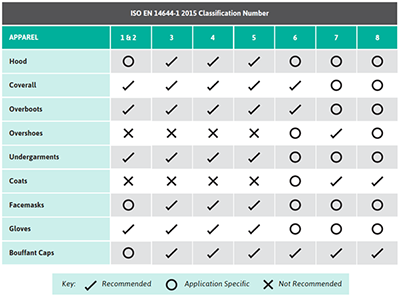
It’s also essential that cleanroom clothing is manufactured
using the correct types of fabrics suitable for cleanrooms and controlled
environments.
When selecting garments for cleanroom use, depending on the
specific application, the IEST standard recommends evaluating the fabric
properties including testing for (selecting those relevant to the fabric type):
- Cleanliness and cleanability
- Electrostatic properties
- Biological properties
- Durability
- Comfort
- Opacity
- Particle filtration efficiency
- Microbial penetration
- Chemical compatibility
- Fluid resistance
Construction of cleanroom garments is another important
consideration, and the IEST standard outlines recommendations for thread and
seam structure. Seams for cleanroom garments should be joining seams to avoid
free-air/particulate passage from the inside of the garment to the outside
environment. The IEST standard recommends for the construction of cleanroom
garments that they are constructed using a bound joining seam, as shown below:
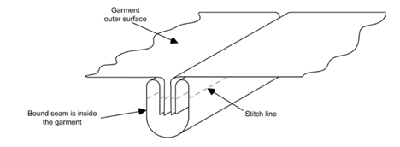
BioClean-D™ Disposable cleanroom garments are manufactured according
to the recommendations set out within the IEST-RP-CC003.4 standard, using the
most effective barrier fabric and the best seam joining for containment of
particles and fibers.
Click here to download the technical release to find
out more information on the composition and structure of cleanroom garments.
|
| |
|
| |
The Physiological Response of Working in Cold Environments and How Your PPE Can Help |
| |
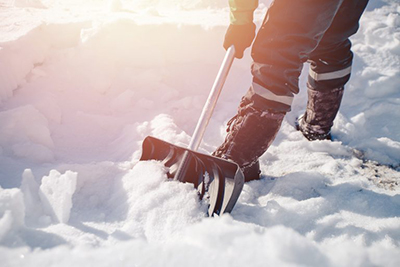
|
| |
Recent NIOSH science blogs have discussed the physiological
impact of wearing respirators. The first blog in this vein explored the Physiological Burden of Prolonged PPE Use on Healthcare
Workers during Long Shifts, including potential CO2 buildup.
A second blog addressed Heat Stress Imposed by PPE Worn in Hot and Humid
Environments and how healthcare workers and their employers
can recognize and mitigate potential stressors. As a third installment of this
series, this blog addresses the general physiological responses to cold stress
while working in cold environments and how personal protective equipment (PPE)
can provide some protection.
Incidence of Hypothermia or Cold
Injury
Due to the lack of a standardized reporting system, the true
incidence of cold injury is not known, but appears to be uncommon across most
of North America except in the northern tier states, including Alaska.
- In 2019, about 1300 people in the U.S. died of hypothermia
- 420 of these deaths, about 32%, were occupationally related
Many occupations require employees to work in cold outdoor
environments (construction, first responders including search and rescue, North
Sea oil and gas workers, etc.). Therefore, it is important to define cold
stress and injury, identify the means to mitigate the exposure to cold, and
provide immediate treatment for cold injury if necessary. Many of these
occupations also require the use of PPE. This begs the question, what is the
role of PPE in the mitigation of cold stress?
Definitions
Cold stress refers
to environmental conditions (e.g., air temperature/humidity, windchill
temperature, rain, and inadequate clothing for protection) in which body heat
is lost to the environment at a rate that is faster than the body can produce
heat. Consult the U.S. Customary Windchill Chart, an integration
of air temperature and wind velocity, to provide an estimate of the cooling
power of the environment. (Note that persons riding in open vehicles may be
subjected to dangerous wind chills even when the natural wind velocity is low).
Cold strain refers
to the physiological responses (e.g., attempts to compensate for body heat loss
through vascular changes, increased metabolic production of heat, and
shivering) involved in preventing or limiting body heat loss. Cold stress may
progress to cold injury and illness. Cold injuries may include hypothermia
(clinical hypothermia is defined as a core body temperature falling below 96.8ºF [35ºC]), frostbite (freezing of tissue causing damage to the skin and
perhaps underlying tissue), non-freezing injuries such as immersion foot
(following reduction of blood flow after exposure to cold and wet environments
which can cause nerve damage), chilblains (redness and swelling of skin of
hands, face after exposure to cold), and cracked skin. As the victim becomes
colder, they may experience muscle rigidity, reduced blood pressure,
cardiovascular effects (rhythm disturbances) and a decrease in respiratory
rate. Cold strain may also involve psychological impact to body heat loss, such
as cognitive decline, poor judgement (paradoxical removal of clothing), and
clouded consciousness.
Hypothermia: Symptoms and
Treatment
- Early Symptoms
- Shivering – attempt to generate heat
- Fatigue
- Loss of coordination
- Confusion and disorientation
- Late Symptoms
- No shivering
- Blue skin
- Dilated pupils
- Slowed pulse and breathing
- Loss of consciousness
- Cardiac dysfunction, cardiac standstill (“flatline”) (established by medical professionals in an emergency department)
- Brain – Isoelectric EEG (“flatline”) (established by medical professionals in an emergency department)
Can PPE Help Protect Against
Cold Strain?
PPE, as the last level of defense within the hierarchy of
controls, is worn to protect against specific external hazards
found in occupational settings. However, some PPE is, by its nature, highly
insulative in addition to its other protective features. Therefore, wearing
insulative PPE when available can be protective in cold environments if the PPE
remains dry. Some examples of cold protective PPE are:
- Insulated coveralls, bunker gear, and jackets
- Insulated waterproof work boots and gloves
- Insulated hoods, facepieces, and goggles
Click here to read more and learn about recommendations for employers and how to make your
clothes work for you while you work!
|
| |
|
| |

|
Watch the FREE Managing Gas Detection Programs in Manufacturing and Transportation Webinar ON DEMAND Today
|
| |
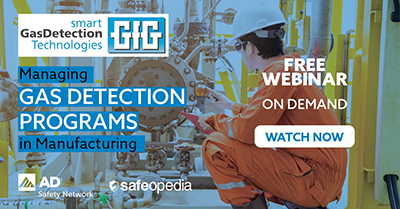
|
| |
Join Robert Henderson, the President of GfG Instrumentation,
Inc., a supplier of portable and fixed gas detection and indoor air quality
monitoring products, as he examines the common challenges and presents solutions
for maintaining a gas detection program in manufacturing and transportation settings,
including managing compliance, personnel, and the products.
Click here to register, and watch the FREE
webinar ON DEMAND today!
|
|
|
|
|

|
|
| National Emphasis Program |
|
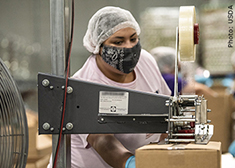
|
|
|
OSHA launched a national emphasis program to protect
high-risk workers from COVID-19 hazards. The program also prioritizes employers
that retaliate against workers who complain about unsafe or unhealthful
conditions.
What is a national emphasis program and why does OSHA institute
them?
National Emphasis Programs (NEPs) are temporary programs that
focus OSHA resources on particular hazards and high-hazard industries.
New and existing programs are evaluated using inspection data, injury and
illness data, National Institute for Occupational Safety and Health reports,
peer-reviewed literature, analysis of inspection findings, and other
information.
|
|
|
|
 |
|
Masks Block More Cough Aerosol Particles than Face Shields
|
|
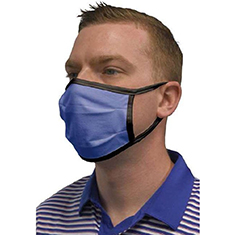
|
|
|
CDC recommends wearing face masks in all public settings to help
prevent the spread of COVID-19. NIOSH recently tested face masks, neck gaiters,
and face shields to see how well they block the small aerosol particles
produced by people when they cough. NIOSH asked lead author William Lindsley,
NIOSH biomedical research engineer, to explain the study, published in the journal Aerosol Science and Technology. Click here to read more on his responses to the efficacy
of the different types of face coverings, if there are any face coverings that often that are not effective, if any face covering is better than no
covering and what questions remain.
|
|
| |
|
| Saf-T-Gard Catalog |
|
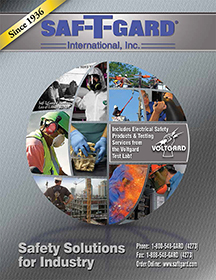
|
|
|
The time for better safety is now!
Click here to request a FREE copy of our current full-line Saf-T-Gard International, Inc. catalog today, and learn how to better GARD yourself with Saf-T-Gard.
Featuring more than 3,900 different line items from more than 100 different brands and fourteen (14) different product categories, this catalog is an excellent resource and provides a wealth of information to help keep you safe and productive for even the most rigorous applications!
|
|
| |
|

|
|
| Closeout Corner - Don't Miss These Great Deals |
|

|
|
|
Saf-T-Gard is making it easier than ever to save big on your favorite safety items with the "Closeout Corner" featured monthly in the Saf-T-Gardian
e-Newsletter.
Click here to view the reduced pricing on all of your must-have items to take advantage of this limited-time pricing and inventory.
Be sure to check back next month for even more products and savings!
|
|
|
|
|
Visit with Saf-T-Gard Virtually
|
|

|
|
|
Hazards exist in every workplace. Common examples include slips,
trips, falls, exposure to loud noises, working from heights, vibrations and
unguarded machinery. The best way to protect your employees is to recognize the
hazards that exist on the job, and control them by utilizing the appropriate
personal protective equipment (PPE) for the application.
This is where Saf-T-Gard can
help! We've been bringing workers home safely since 1936 with our finest
industrial safety products and PPE, and we can do the same for you. Stop by our virtual booth at the following trade show to check out our
comprehensive selection of safety products and services that directly address
every workplace safety hazard.
Wisconsin Safety Council Annual Conference - Tuesday, April 20, 2021 from 8:00 a.m. to 12:45 p.m. (CST),
Wednesday, April 21, 2021 from 8:00 a.m. to 12:45 p.m. (CST),
Thursday, April 22, 2021 from 8:00 a.m. to 12:45 p.m. (CST),
Thursday, April 22, 2021 from 8:45 a.m. to 9:45 a.m. (CST) - Richard Rivkin’s Presentation: “A Shocking Need for Electrical Safety,
Inspection & Testing”
|
|
| |
|
| Safety Tips |
|
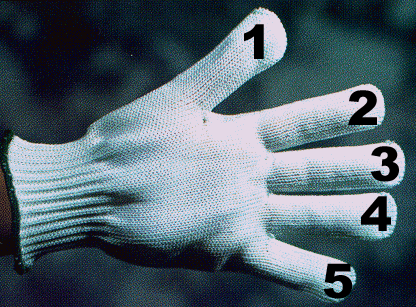
|
|
|
1. ANTI-NOISE - Disposable, expandable foam earplugs offer convenient, low-cost ear
protection
2. ANTI-NOISE - Pre-molded, reusable earplugs are washable and are often available in
different sizes for a better fit
3. ANTI-NOISE - Canal caps on a headband or neckband offer the lightweight convenience
of being able to easily and quickly remove the ear protection when not needed
4. ANTI-NOISE - Earmuffs come in many different styles, sizes, weights, and profiles
5. ANTI-NOISE - Earmuffs are also available as a cap-mounted attachment for those who
wear safety caps
|
|
| |
|
| Q&A |

|
|
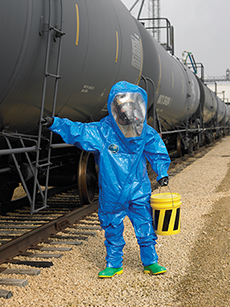
|
|
|
Question – “Does OSHA mandate that all volunteer members of a HAZMAT team be
required to participate in medical surveillance, or may an employee opt out of
medical surveillance?”
Answer - Medical surveillance requirements for personnel involved in emergency
response to the release of hazardous substances, i.e., HAZMAT team members, are
set forth in 1910.120(q)(9). Paragraph 1910.120(q)(9)(i) provides:
"Members of an organized and designated HAZMAT team and hazardous
materials specialists shall receive a baseline physical examination and be
provided with medical surveillance as required in paragraph 1910.120(f) of this
section." Therefore, HAZMAT team members involved in emergency response
operations covered by 1910.120(q)(9)(i) must receive a baseline physical exam.
Any employee subject to 1910.120(q)(9) who elects not to have a baseline
examination may not perform emergency response duties as part of a HAZMAT team
or as a hazardous materials specialist. An employee who is a
"volunteer" member of a HAZMAT team or hazardous materials specialist
must still receive the baseline examination under paragraph 1910.120(q)(9)(i).
That paragraph applies to all members of any organized and designated HAZMAT
team. Any employee who is expected to respond to hazardous substance releases
as a HAZMAT team member with the knowledge of the employer is covered under the
requirements.
|
|
| |
|
| Saf-T-Gard Spotlight |
|

|
|
|
Ellie McGivern is our marketing specialist. She has worked at
Saf-T-Gard since September 2014, starting first as a marketing intern before
beginning promoted to a marketing coordinator in May 2015 and marketing
specialist in August 2018.
What Ellie likes about Saf-T-Gard:
“I enjoy the creative freedom I have in designing graphics that
reflect Saf-T-Gard’s established brand and learning all the ins and outs about
the company.”
What makes Ellie's day:
“Getting everything on my to-do list accomplished!”
Ellie’s outside interests:
“I enjoy spending my time cooking up new recipes and listening
to music.”
Anything else?
“I
am glad to be a part of the Saf-T-Gard team, and I look forward to seeing what
the future holds!”
|
|
| |
|
 Factoid Factoid |
|
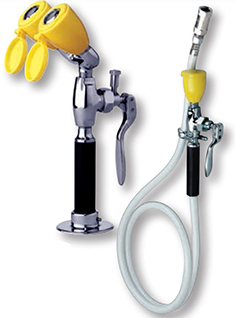
|
|
|
Who is responsible for providing the quick drenching and flushing
facilities where there is exposure to corrosive materials? Are small businesses
(e.g., retail stores) subject to 29 CFR 1910.151(c), if they handle corrosive
liquid materials?
Every employer with employees exposed to the corrosive chemicals is
responsible for the safety and health of their employees. Paragraph (c) of 29
CFR 1910.151 requires that suitable facilities for quick drenching or flushing
be provided within the work area for immediate use if an employee's eyes or
body may be exposed to corrosive materials. The OSHA standard does not set
specifications for emergency eyewash and shower equipment, but we agree that
equipment that complies with ANSI (ANSI Z358.1-2004, American National Standard
for Emergency Eyewash and Shower Equipment) requirements would usually meet
the intent of the OSHA standard. It should also be noted that, in addition to
the requirement for emergency flushing and drenching facilities, there are also
requirements for personal protective equipment (PPE) when employees are exposed
to the hazards in which corrosive chemicals are present. PPE requirements are found in
Subpart I, Personal Protective Equipment, of 29 CFR §1910 and may include, but
are not limited to, protection for the eyes, face, and hands, as well as
protective clothing. The purpose of PPE is to prevent injury, whereas the
purpose of the eye wash or shower is to minimize injury, should that first line
of defense fail. And yes. All employers, regardless of size, that have
employees whose eyes or body may be exposed to injurious corrosive materials
must provide quick drenching and flushing facilities.
|
|
| |
|
| As I See It |
|

|
|
|
It is March 2021 and maybe, just maybe, our long dark
Year-Of-The-Pandemic is actually improving. Without getting political, the
combination of 3 vaccines approved for Emergency Use plus other measures taken
over the past 12 months seems to be reducing the numbers of cases,
hospitalizations, and fatalities.
So what have we learned so far from this pandemic, from a safety
perspective? First of all, trust your PPE and your PPE supplier. There are
continuing horror stories of fake and counterfeit N95 respirators which put
people’s lives at risk. And there are other horror stories of disposable gloves
being sold with counterfeit FDA certificates and questionable quality. If you
wouldn’t buy food or medicine at a hardware store (and I like most hardware
stores), then you shouldn’t buy PPE from non-safety-specialists.
Secondly, a pandemic-forced acceptance with virtual meetings
(Zoom, etc.) means that we can provide customers with access to safety product
technical specialists from anywhere in the world without regard to travel
schedules. Need to understand technical details such as OSHA PELs for chemical
exposure – we can get a specialist to explain it.
Third, we are all more cautious about visitors in our
facilities. The nice person who refills the first aid kit or cabinet or the
other nice person who refills the PPE vending machine can be health risks to
your workplace and workforce. We have technological and process solutions to
eliminate those risks while gaining a high degree of efficiency,
accountability, responsibility, and practicality.
How
do we know this? Because we are Saf-T-Gard International - Bringing
Workers Home Safely Since 1936.
|
|
|
